...
| Excerpt Include |
|---|
| Creating a simple form in Confluence with ConfiForms |
|---|
| Creating a simple form in Confluence with ConfiForms |
|---|
| nopanel | true |
|---|
|
This is how the final form looks like
...
| Expand |
|---|
| Code Block |
|---|
<ac:structured-macro ac:macro-id="7090c376-21fb-4e40-9249-f6fe32aa62f3" ac:name="confiform" ac:schema-version="1">
<ac:parameter ac:name="formName">f</ac:parameter>
<ac:parameter ac:name="saveButtonLabel">Send</ac:parameter>
<ac:parameter ac:name="registrationFormTitle">Send notification</ac:parameter>
<ac:rich-text-body>
<p>
<ac:structured-macro ac:macro-id="303ecca1-bb19-44c9-b188-990db8e3c711" ac:name="confiform-field-definition"
ac:schema-version="1">
<ac:parameter ac:name="fieldName">name</ac:parameter>
<ac:parameter ac:name="fieldLabel">Name</ac:parameter>
<ac:parameter ac:name="type">user</ac:parameter>
</ac:structured-macro>
</p>
<ac:structured-macro ac:macro-id="c0a8c1cf-326d-4321-ab1f-8ef743bdc8d6" ac:name="confiform-field-definition"
ac:schema-version="1">
<ac:parameter ac:name="fieldName">message</ac:parameter>
<ac:parameter ac:name="fieldLabel">Message</ac:parameter>
<ac:parameter ac:name="type">textarea</ac:parameter>
</ac:structured-macro>
<p>
<ac:structured-macro ac:macro-id="052bc766-c50c-4396-a666-8f2436ef01bf" ac:name="confiform-entry-register"
ac:schema-version="1">
<ac:parameter ac:name="registrationMessage">Notification has been sent</ac:parameter>
<ac:parameter ac:name="registrationButtonLabel">Send notification</ac:parameter>
<ac:parameter ac:name="embedded">true</ac:parameter>
<ac:parameter ac:name="atlassian-macro-output-type">INLINE</ac:parameter>
<ac:rich-text-body>
<p> </p>
</ac:rich-text-body>
</ac:structured-macro>
</p>
<ac:structured-macro ac:macro-id="5f096006-a6fc-4243-8e71-8f3e09907c2e" ac:name="confiform-ifttt"
ac:schema-version="1">
<ac:parameter ac:name="action">Send Notification</ac:parameter>
<ac:parameter ac:name="event">onCreated</ac:parameter>
<ac:parameter ac:name="title">Hello [entry.name.fullName]</ac:parameter>
<ac:rich-text-body>
<p>[entry.message]</p>
</ac:rich-text-body>
</ac:structured-macro>
<ac:structured-macro ac:macro-id="cd72d761-5c5b-4fb3-bea5-9bb9c8496b67" ac:name="confiform-ifttt"
ac:schema-version="1">
<ac:parameter ac:name="action">Delete ConfiForms Entry</ac:parameter>
<ac:parameter ac:name="event">onCreated</ac:parameter>
<ac:parameter ac:name="title">id:[entry.id]</ac:parameter>
<ac:parameter ac:name="who">f:884778</ac:parameter>
<ac:rich-text-body>
<p> </p>
</ac:rich-text-body>
</ac:structured-macro>
</ac:rich-text-body>
</ac:structured-macro> |
|
And this is how it looks in the editor
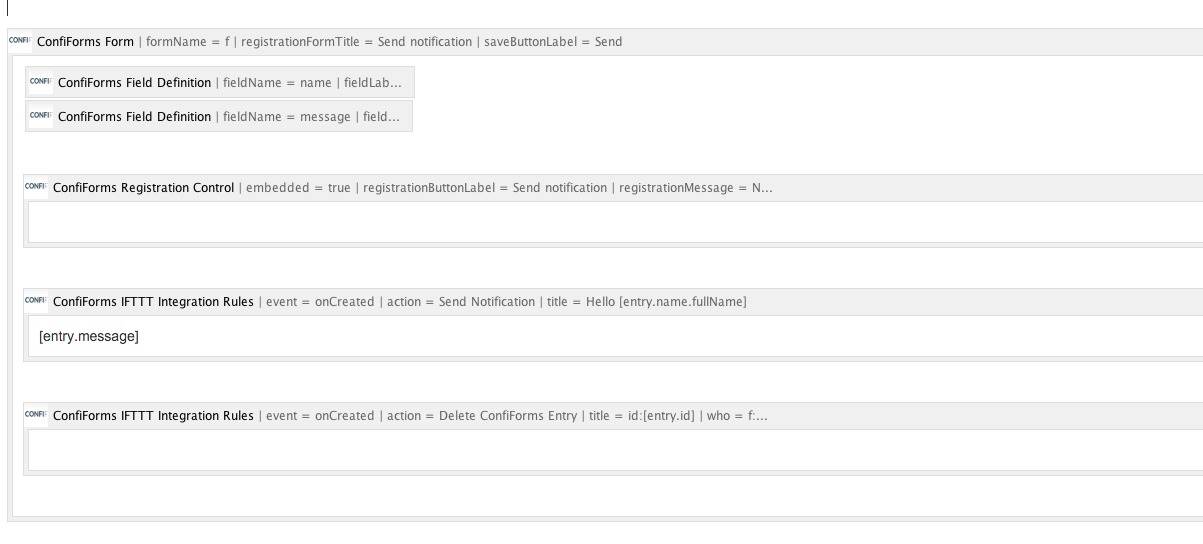
Let's see what it consists of:
- As usual, everything is ConfiForms Form container, we have set custom title and custom label for main action button
- Then we have 2 fields (ConfiForms Field Definition macros): name and message. Name is of type "user" and Message is of type "textarea"
- Then we have a ConfiForms Registration Control, which tells us how the form should be shown (we have selected it to be embedded to the page) and we set custom messages and labels
- Then we have 2 ConfiForms IFTTT macros, or handlers as we usually call it. The ordering is important! The first one sends notification and the second one deletes the original ConfiForms record which was used initially to sent the notification
Below, you can see screenshots for Registration Control and screenshots for these 2 IFTTT handlers
Configuration for ConfiForms Registration Control

Configuration for ConfiForms IFTTT macro which sends notifications
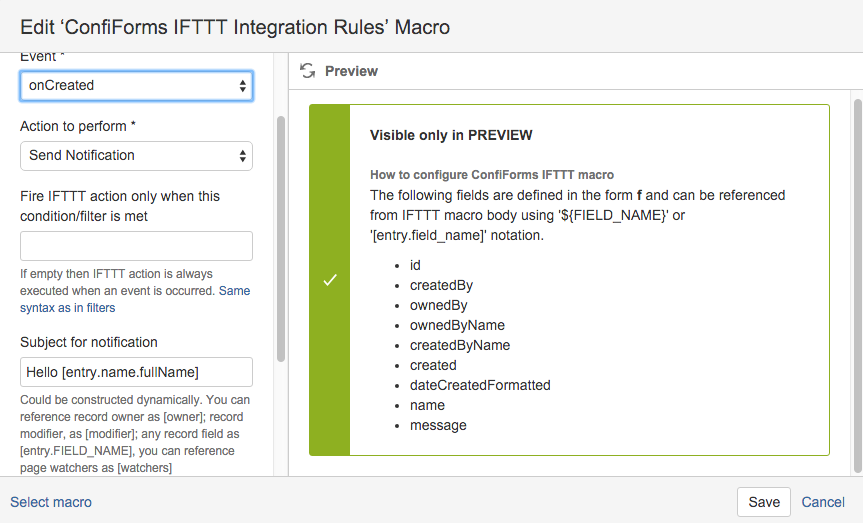
Here we set a subject to be dynamic, and as "user" object is a "complex" object we can query some additional properties (See documentation for more details on properties of "complex" objects: Documentation)
Second IFTTT deletes the record (we set a dynamic filter, which will filter only one record)
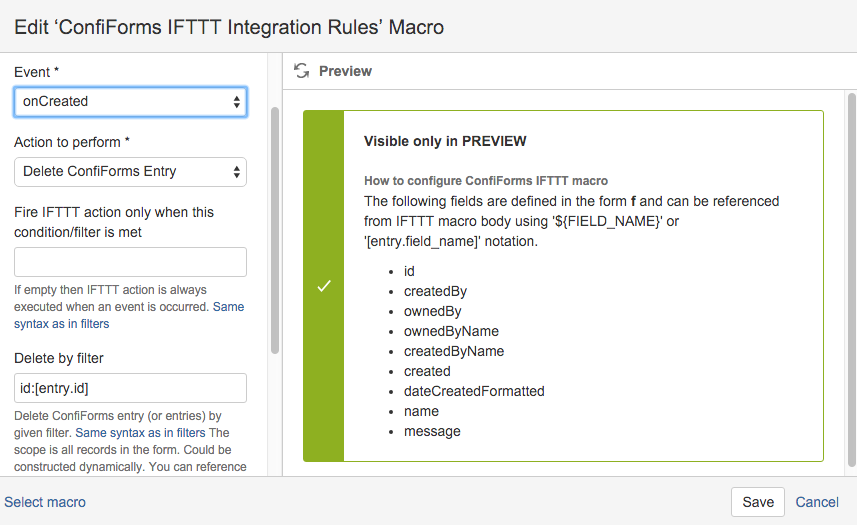
The important bit (shown below, as it did not fit into the previous screenshot) is the last parameter, called "Form name and pageId":
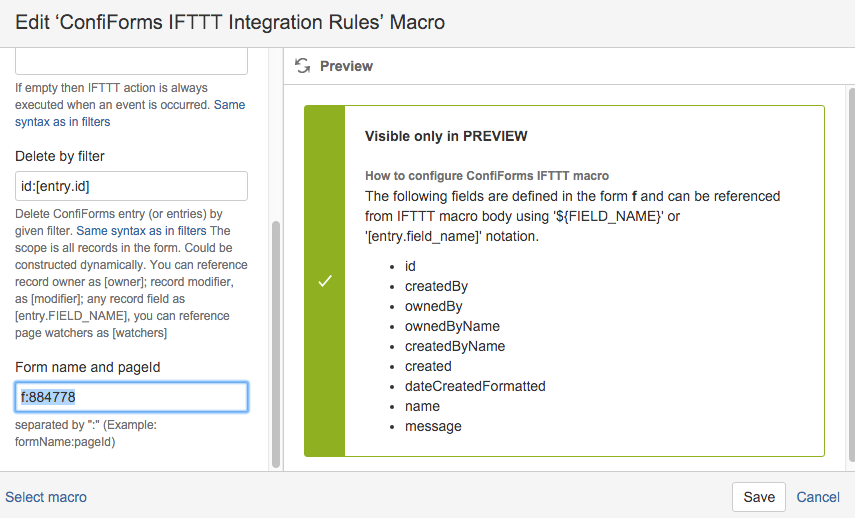
which set's the name of the form this filter (and action) should be applied on, as well as the location (pageId of the page where this form is configured)
In our case the form name is "f" and it is on the page with page Id = 884778
The end result looks like this (notification and actually empty table):
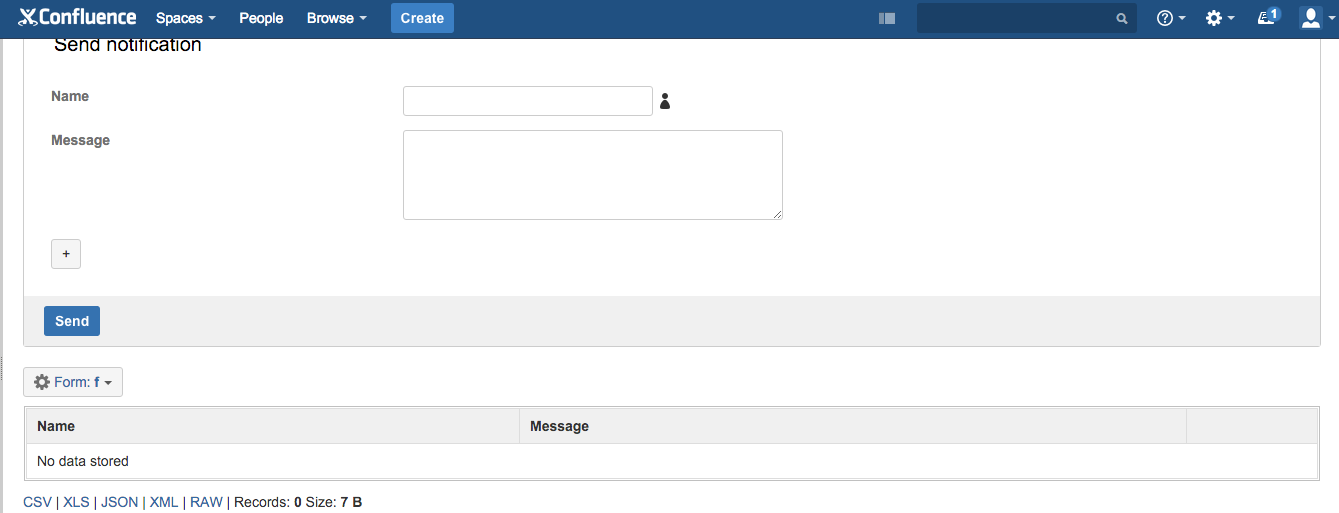
| Warning |
|---|
This will not work for "Anonymous forms"! The reason is: a record stored does not have an owner and therefore could not be deleted by anyone than a form administrator |





